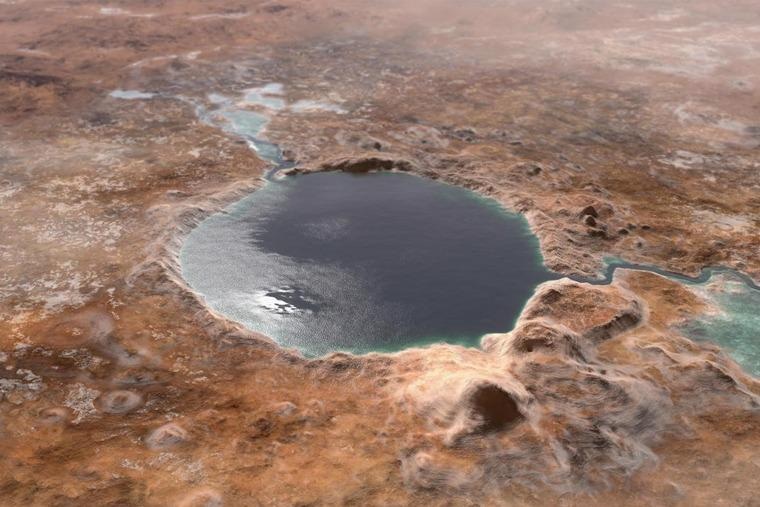Dec 1 2020
With regard to water and Mars, it is a mixture of good news and not-so-good news. The good news is that there is water on Mars and the not-so-good news is that it is salty.
 This illustration shows Jezero Crater—the landing site of the Mars 2020 Perseverance rover—as it may have looked billions of years ago on Mars, when it was a lake. At Washington University in St. Louis, Vijay Ramani’s lab has developed a way to extract hydrogen and oxygen out of the briny water that may remain under the Martian surface. Image Credit: NASA/JPL-Caltech.
This illustration shows Jezero Crater—the landing site of the Mars 2020 Perseverance rover—as it may have looked billions of years ago on Mars, when it was a lake. At Washington University in St. Louis, Vijay Ramani’s lab has developed a way to extract hydrogen and oxygen out of the briny water that may remain under the Martian surface. Image Credit: NASA/JPL-Caltech.
The Red Planet is extremely cold; water that is not frozen is nearly full of salt from the Martian soil, which minimizes its freezing temperature.
Salty water cannot be consumed, and the common technique of using electricity (electrolysis) to disintegrate it into oxygen (to breathe) and hydrogen (for fuel) necessitates removal of the salt—a laborious, expensive task in a challenging, unsafe environment.
However, if oxygen and hydrogen could be extracted directly from salty water, that salt electrolysis process would be a lot less complicated—and not so costly as well.
Engineers from the McKelvey School of Engineering at Washington University in St. Louis have built a system that performs just that. Their study was published recently in the Proceedings of the National Academy of Sciences (PNAS).
Headed by Vijay Ramani, the Roma B. and Raymond H. Wittcoff Distinguished University Professor in the Department of Energy, Environmental and Chemical Engineering, the team did not just validate its brine electrolysis system under standard terrestrial conditions; the system was studied under a simulated Martian atmosphere at −33 °F (−36 °C).
“Our Martian brine electrolyzer radically changes the logistical calculus of missions to Mars and beyond,” stated Ramani. “This technology is equally useful on Earth where it opens up the oceans as a viable oxygen and fuel source.”
In 2008 summer, NASA’s Phoenix Mars Lander “touched and tasted” Martian water and excavated vapors from melted ice. From that time, the European Space Agency’s Mars Express has detected a number of underground ponds of water that remain in a liquid state due to the presence of magnesium perchlorate—salt.
To live—even for some time—on Mars, not to mention about returning to Earth, astronauts will have to produce some of the essentials, such as fuel and water, on the Red Planet. The Perseverance rover from NASA is currently en route to Mars, carrying gadgets that will use high-temperature electrolysis.
But the Mars Oxygen In-Situ Resource Utilization Experiment (MOXIE) will be generating only oxygen, from the carbon dioxide in the Martian atmosphere.
The system created in Ramani’s lab can generate 25 times more oxygen compared MOXIE using the same power. It also yields hydrogen, which could be used to power the astronauts’ journey home.
Our novel brine electrolyzer incorporates a lead ruthenate pyrochlore anode developed by our team in conjunction with a platinum on carbon cathode. These carefully designed components coupled with the optimal use of traditional electrochemical engineering principles has yielded this high performance.
Vijay Ramani, Roma B. and Raymond H. Wittcoff Distinguished University Professor, Department of Energy, Environmental and Chemical Engineering, Washington University
The meticulous design and exclusive anode enable the system to work without the need for heating or refining the water source.
Paradoxically, the dissolved perchlorate in the water, so-called impurities, actually help in an environment like that of Mars. They prevent the water from freezing, and also improve the performance of the electrolyzer system by lowering the electrical resistance.
Shrihari Sankarasubramanian, Study Joint First Author, Washington University
Sankarasubramanian is a research scientist in Ramani’s group.
In general, water electrolyzers use extremely purified, deionized water, which increases the cost of the system. A system that can run with “sub-optimal” or salty water, such as the technology showcased by Ramani’s team, can considerably improve the economic value proposition of water electrolyzers universally—even on Earth.
Having demonstrated these electrolyzers under demanding Martian conditions, we intend to also deploy them under much milder conditions on Earth to utilize brackish or salt water feeds to produce hydrogen and oxygen, for example, through seawater electrolysis.
Pralay Gayen, Study Joint First Author, Washington University
Gayen is a postdoctoral research associate in Ramani’s Group.
Applications such as these could be beneficial in the defense domain, for instance, to produce oxygen on demand in submarines. It could also deliver oxygen as scientists explore unfamiliar locations closer to home, in the deep sea.
The principal technologies facilitating the salt electrolyzer system are the subject of patent filing through the Office of Technology Management and can be licensed from the university.
Journal Reference
Gayen, P., et al. (2020) Fuel and oxygen harvesting from Martian regolithic brine. Proceedings of the National Academy of Sciences. doi.org/10.1073/pnas.2008613117.